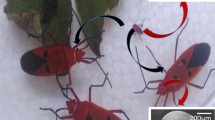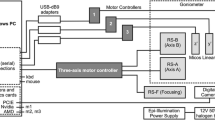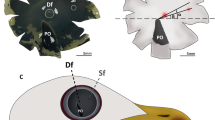Summary
The possibility that a special area of the eye of the praying mantis Stagmatoptera biocellata was implicated in estimation of catching distance, was investigated.
1.The right eye of the female mantis was painted blinding only a restricted area of the eye. A special apparatus called the double-goniometer (Fig. 2 and 3) was used to obtain a coordinate system of reference and to determine, thus, which zone of the eye had been covered. The experimental device took advantage of the conspicuous pseudopupil of Stagmatoptera biocellata.
2.A simple projection map of the right eye (frontal part) with the isopseudopupil lines (Fig. 5) is presented to illustrate the different zones that were painted and their comparative sizes (Figs. 6–9).
3.16 groups of animals with different blinded areas were used. Their hitting ability on a prey was measured in an experimental device described elsewhere (Maldonado, Levin and Barros-Pita, 1967) and compared with that of two control groups. One control group had both eyes free (the binocular group or group B) and the second control group had the whole right eye blinded (the monocular group or Group M). Animals of Group 15 (painted area is shown in Fig. 9; 15) performed as badly as the monocular mantids. Any other pattern of painting that did not include all the area of group 15, showed a number of successful strikes significantly greater than Group M. This finding proved to be true in spite that even more extense zones than those of Group 15 were blinded.
4.These results indicate that there exists an area in the female mantis eye that is, as a whole, necessary and sufficient for a fine estimation of catching distance. We call it a fovea by functional analogy with that of the eye of some vertebrates with great overlapping frontal fields.
Similar content being viewed by others
References
Burkhardt, D., de la Motte, I., Seitz, G.: Physiological optics of the compound eye of the blow fly. In the functional organization of the compound eye, p. 51–62. Oxford: Pergamon Press 1966.
Graham, C. G.: Visual Space perception. In Vision and visual preception, p. 504–547. New York: John Wiley & Sons 1965.
Helmholtz, H. L. F. von: Treatise on physiological optica. New York: Opt. Soc. Amer. 1924.
Kirschfeld, K.: Die Projektion der optischen Umwelt auf das Raster der Rhabdomere im Komplexauge von Musca. Exp. Brain Res. 3, 248–270 (1967).
Leverault, P.: The morphology of the Carolina mantis. Univ. Kansas Sci. Bull. 14, 205–259 (1936).
Levin, L., Maldonado, H.: A fovea in the praying mantis eye. III. The centring of the prey. Z. vergl. Physiol. 67, 93–101 (1970).
Maldonado, H., Levin, L.: Distance estimation and the monocular cleaning reflex in praying mantis. Z. vergl. Physiol. 56, 258–267 (1967).
—, Barrós-Pita, J. C.: Hit distance and the predatory strike of the praying mantis. Z. vergl. Physiol. 56, 237–257 (1967).
Seitz, G.: Der Strahlengang im Appositionsauge von Calliphora erythrocephala (Meig.). Z. vergl. Physiol. 59, 205–231 (1968).
Wallace, G. K.: Visual scanning in the desert locust Schistocerca gregaria Forskoal. J. exp. Biol. 36, 512–525 (1959).
Author information
Authors and Affiliations
Additional information
We are indebted to Dr. G. Whittembury and Dr. F. Herrera for reading the manuscript and for helpful criticism. We wish to thank Prof. Dr. Max Beier for taxonomical identification of the praying mantis. Figures have been drawn by Mr. J. Machin and C. Quintero.
Rights and permissions
About this article
Cite this article
Maldonado, H., Barrós-Pita, J.C. A fovea in the praying mantis eye. Z. Vergl. Physiol. 67, 58–78 (1970). https://doi.org/10.1007/BF00298119
Received:
Issue Date:
DOI: https://doi.org/10.1007/BF00298119




